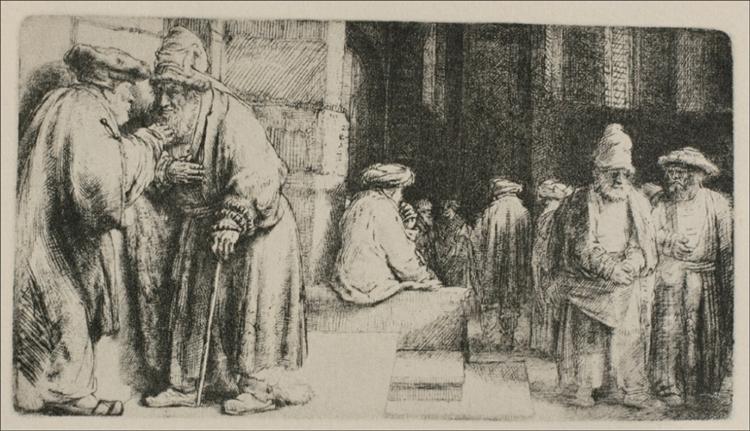Opis
W „La Sinagoga”, namalowanym przez Rembrandta w 1648 r., Istnieje dzieło głębokiego rezonansu emocjonalnego i technicznego, charakterystycznego dla holenderskiego nauczyciela. Obraz jest zapisany do kontekstu historycznego i kulturowego, w którym społeczność żydowska zaczęła być zauważana w Europie, a sztuka Rembrandta odzwierciedla wyjątkową fuzję duchowości i ludzkości, która charakteryzuje jej pracę.
Skład pracy jest niezwykły ze względu na jego strukturę, która podkreśla wielkość budynku religijnego, w którym rozwija się scena. Na pierwszym planie duży łuk budynku działa jako rama dla centralnej postaci, która stanowi personifikację synagogi. Atmosfera jest zaimpregnowana dramatycznym oświetleniem, które jest charakterystyczne dla zastosowania, jakie Rembrandt wytwarza Chiaroscuro, w którym światła i cienie są przeplatane, aby stworzyć poczucie głębokości i trzech wymiarów. Światło tutaj nie tylko oświetla, ale także sugeruje głębsze znaczenia, takie jak wiedza i wiara.
Jeśli chodzi o kolor, zastosowana paleta jest głównie ciemna, z ziemskimi tonami i niuansami, które wywołują uroczystość tego miejsca. Możesz zobaczyć, w jaki sposób niuanse ciepłych kolorów kontrastują i wzmacniają centralną postać, która ubrana w skomplikowane ubrania znajduje się na progu duchowego objawienia. Delikatność szczegółów w fałdach ich odzieży, a także subtelność dotyku światła, które ujawniają tekstury, pokazują techniczne opanowanie Rembrandta w reprezentacji materiału.
Postać synagogi jest przedstawiana jako istota humanizowana, w przeciwieństwie do abstrakcyjnego i uroczystego obrazu, który często kojarzy się z instytucjami religijnymi. Jego pozycja, która wydaje się kontemplacyjna, sugeruje stan refleksji, mrugnięcie do poszukiwania wiedzy i prawdy. To odchodzi od najbardziej sztywnych i sztywnych ikonografii typowych dla dzieł religijnych tamtych czasów, podkreślając indywidualność i psychologię stojącą za postacią religijną.
To podejście Rembrandt rezonuje głęboko z twoim ciałem, w którym emocjonalne cechy jego bohaterów i narracyjny charakter jego scen pozwalają na intymne połączenie między widzem a pracą. Podobnie jak w pracach lepiej znanych jako „La Ronda de Noche”, w którym można również obserwować skrupulatną dbałość o przestrzeń i interakcję światła, „LA Synagoga” wyróżnia się odruchowym użyciem światła jako kluczowego elementu narracyjnego.
Warto zauważyć, że „synagoga” była częścią uzupełniającego się dzieła, znanego jako „Kościół”, w którym tkany jest kontrast między tradycjami żydowskimi i chrześcijańskimi. Ta paralela, choć przez wieki, rezonuje z duchem dochodzenia, które posiadał Rembrandt, chęć odkrywania i zrozumienia ludzkiej kondycji we wszystkich jego wymiarach.
Wreszcie „La Sinagoga” oferuje medytację o wiary, społeczności i poszukiwania prawdy w kontekście obciążonej transformacją społeczną i duchową. Praca zachęca nas do refleksji nad relacjami między sztuką a tożsamością kulturową, ujawniając, jak Rembrandt, poprzez swój geniusz, udaje się uchwycić esencję swoich czasów, jednocześnie oferując okno na wieczność ludzkiego doświadczenia. Jest to świadectwo zdolności sztuki do łączenia wizji i przekonań, wizualnej narracji, która wciąż rezonuje.
KUADROS ©, słynna farba na twojej ścianie.
Ręcznie wykonane obrazy olejne, z jakością profesjonalnych artystów i charakterystyczną pieczęcią KUADROS ©.
Usługa reprodukcji zdjęć z gwarancją satysfakcji. Jeśli nie jesteś w pełni zadowolony z repliki twojego obrazu, zwrócimy twoje pieniądze w 100%.

